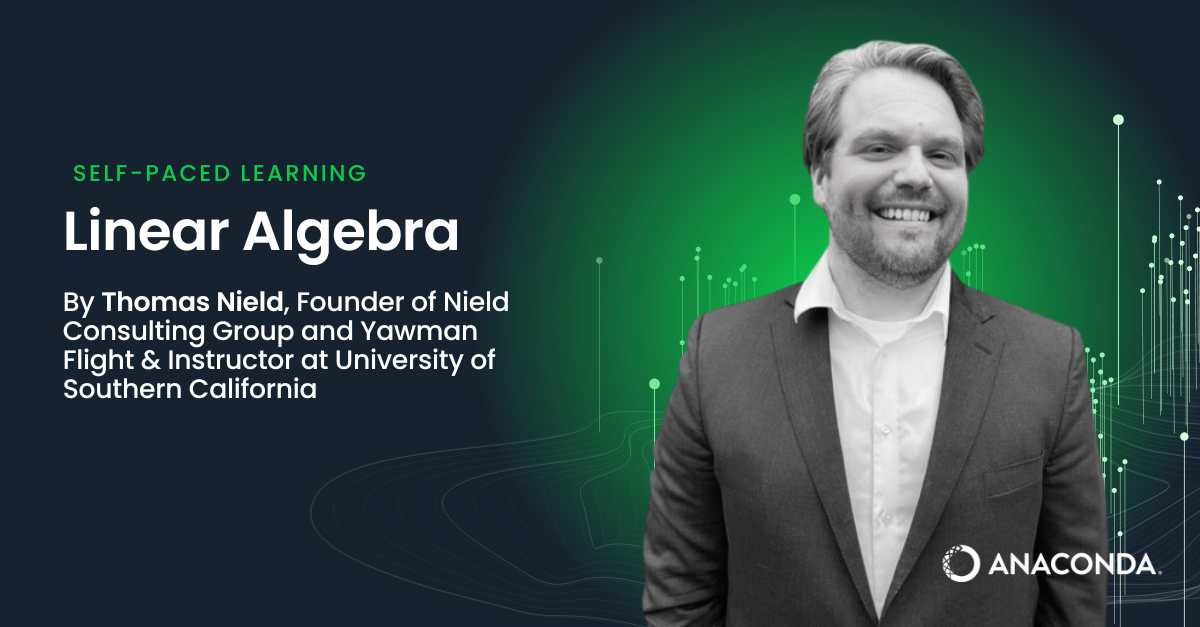- Getting Started
-
How to use Anaconda Notebooks 00:01:02
-
Course Overview and Learning Objectives 00:02:23
- Vectors
-
What is a Vector? 00:07:23
-
Declaring a Vector in NumPy 00:11:39
-
Adding and Scaling Vectors 00:05:01
-
Exercise: Combine the Vectors 00:02:02
- Matrices
-
What is a Matrix? 00:04:25
-
i-hat and j-hat 00:02:40
-
Matrix Vector Multiplication 00:08:48
-
Types of Linear Transformations 00:07:13
-
Exercise: Execute the Transformation 00:04:07
- Linear Algebra in 3D
-
Vectors in Higher Dimensions 00:04:41
-
Transformations in Higher Dimensions 00:03:47
-
Tensors and Higher Dimensional Data 00:10:37
-
Exercise: Transforming High-Dimensional Vectors 00:02:18
- Determinants and Special Cases
-
The Determinant 00:06:06
-
Linear Dependence 00:06:05
-
Special Case Matrices 00:05:51
-
Exercise: Is This Matrix Linear Dependent? 00:01:21
- Matrix Multiplication
-
Combining Transformations 00:04:43
-
Inverse Matrices 00:04:23
-
Understanding the Dot Product 00:04:54
-
Exercise: Combine the Matrices 00:02:43
- Practical Applications
-
System of Equations 00:09:07
-
Eigendecomposition 00:04:28
-
Linear Regression 00:07:25
-
Neural Networks 00:13:07
-
Exercise: Solve the System of Equations 00:02:21
- Conclusion
-
Summary and Further Reading Resources 00:03:35
-
End of Course Survey

Linear Algebra
Fundamentals of matrix and vector operations in Python.
Linear algebra is the backbone of machine learning, statistics, and modern numerical computing. By expressing data through vectors, matrices, and linear transformations, you can capture complex operations using these simple (albeit abstract) building blocks. From computer graphics to machine learning, linear algebra seems to touch every aspect of data and computing.
This course will cover the fundamental ideas of linear algebra, including visualizing vectors, matrices, and linear transformations. Along the way, we'll cover how to express these operations in Python using NumPy and how they can be applied to practical problems from fitting a linear regression model to building a neural network.
By the end of this hands-on course, you’ll understand:
- Why linear algebra is the building block to data science and machine learning
- How data and models come to life with linear transformations by using Python and NumPy
- How linear algebra has visual interpretations for concepts like determinants and inverse matrices
And you’ll be able to:
- Apply linear transformations to vector spaces and visualize them
- Leverage techniques like matrix decomposition to fit a linear regression
- Declare a neural network using only vectors and matrices
This training is for you because...
- You are a data science professional who needs to understand how data operations are done with vectors and matrices
- You are a machine learning practitioner wanting a more visual intuition on linear algebra, not just a numerical one
- You are a software engineer interested in numerical computing, but need an understanding of linear algebra first
Prerequisites
- Basic proficiency with Python, including variables, math operations, functions, loops, and library usage.
Setup
To open Anaconda Notebooks:
- Go to https://anaconda.cloud
- Click on 'Notebooks' from the top navigation menu
- Create an account or login if you already have one
Recommended preparation
- Introduction to Python Programming learning path
Recommended follow-up
- Statistics and Hypothesis Testing on-demand course
- Probability Fundamentals on-demand course
- Introduction to Machine Learning on-demand course
Facilitator bio
Thomas Nield is the founder of Nield Consulting Group and Yawman Flight, as well as an instructor at University of Southern California. He enjoys making technical content relatable and relevant to those unfamiliar or intimidated by it. Thomas regularly teaches classes on data analysis, machine learning, mathematical optimization, and practical artificial intelligence. At USC, he teaches AI System Safety, developing systematic approaches for identifying AI-related hazards in aviation and ground vehicles. He's authored three books, including Essential Math for Data Science (O’Reilly) and Getting Started with SQL (O'Reilly).
He is also the founder and inventor of Yawman Flight, a company developing universal handheld flight controls for flight simulation and unmanned aerial vehicles. You can find him on Twitter | LinkedIn | GitHub | YouTube.
Questions? Issues? Contact [email protected].



